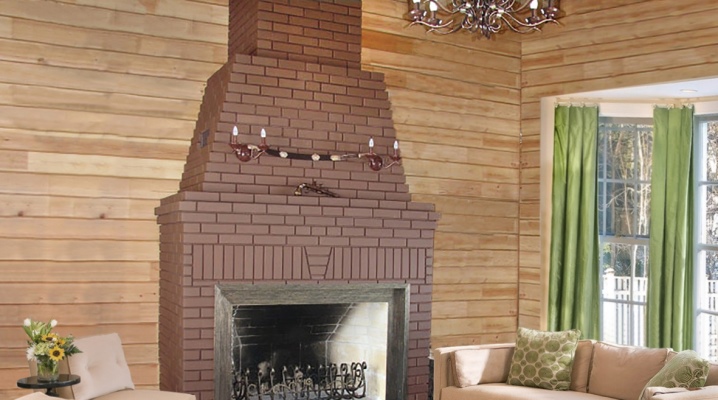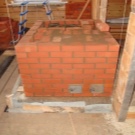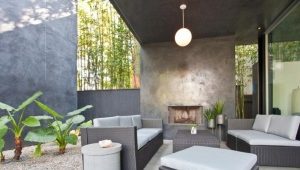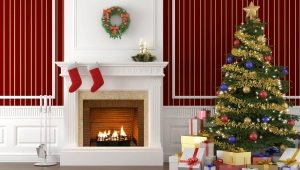Sizes of brick fireplaces
To build a fireplace with his own hands seems to many an overwhelming task. And it is completely in vain. Everything turns out to be quite simple with the right and thorough approach to the matter. The sizes of fireplaces from a brick are defined depending on the area of the room and everyone can understand it.
Where to start
First you need to determine the location of the fireplace in the house. It is undesirable to place it in front of the windows, as then there will be drafts. The back wall of the fireplace can be very hot, so it is better that it adjoins the outer walls of the house. In wooden houses, in order to avoid fire, additional measures should be taken to eliminate this danger.
Dimensioning should start with a firebox.
They are defined as follows: the area of the room in which the fireplace is located, refers to the area of the firebox as 1:50 - 1:70.
So, for a room of 20 square meters. m and a standard ceiling height (3 - 3.5 m) portal area of the firebox will be 0.4 square meters. m or 52 × 77 cm
Similarly, for a room of 15 square meters. m - 0.3 square meters.m or 44 × 67 cm
For a room of 10 square meters. m - 0.2 square meters. m or 36 × 45 cm
The depth of the firebox should be from ½ to 2/3 of the height of the portal. It is important to follow this rule, otherwise it will be unpleasantly reflected in the operation of the fireplace. Too shallow depth will lead to smoke, and too much depth will lead to loss of heat transfer.
The size of the chimney is determined by the size of the furnace. Its area should be about 8 - 15 times smaller. If you plan to make a brick chimney, the dimensions will be 14 × 14 and 14 × 27 cm. When using a stainless pipe - 8 - 14 cm. The standard height of the chimney is 4 - 5 m.
The overall dimensions of the fireplace are determined based on the brick standards: 6.5 × 12 × 25 cm. Taking into account the thickness of the seams, the height of one row of masonry will be 7 cm. The back wall can be made in a half-brick - 12.5 cm. The side walls in one brick are 25 cm.
Experts strongly recommend that before starting work to make on paper a drawing of the future fireplace.
Together with the ordering scheme (schemes where for each row the order of location of bricks in it is indicated), it will allow to determine the number of bricks needed for work. It is worth considering that the ready-made schemes with the already calculated amount of material consider each half and three-fourths as a whole brick.
For beginners, to avoid unpleasant surprises, it is preferable to use ready-made ordering schemes. It must be remembered that, even clearly following such a scheme, the actual consumption of material may differ from the stated.
The type of fireplace also plays a role. So, about 200 pieces will go to an angular fireplace with dimensions of 1 × 1 meter. red bricks and 100 pcs. refractory. For a simple fireplace with dimensions of 65 × 115 cm, the amount of red brick is approximately 250 pieces, and the fireclay is 100. For a traditional large English fireplace, 300 pieces will already be needed. red and 130 fireclay.
To assess the size and ensure the correctness of the calculation is to make a dry laying.
Those. to lay down the fireplace according to the order procedure without a solution, and then, having disassembled, proceed to the real laying. This will avoid errors, not too lengthening the process.
Foundation
The foundation is an important and responsible stage of work. Laying the foundation for the fireplace, it is worth considering the following points:
- the foundation of the fireplace should not come into contact with the main foundation of the house;
- the dimensions of the foundation must be greater than the dimensions of the fireplace by about 10 cm on each side;
- the depth of the pit should be 50-60 cm;
- the level of the foundation must be lowered from the floor level to the height of one brick - 6-7 cm;
- to put a fireplace on a fully prepared, frozen foundation.
The foundation is made of brick or concrete.
Concrete is more complex in execution, so we dwell on it.
On the bottom of the pit, rubble is covered with a thickness of 10 to 15 cm. They install the formwork by treating with resin or upholstering roofing material. Fill the foundation with sand-cement mortar (3 parts of pitch and 1 part of cement). After leveling the foundation, they leave it to dry for a week under plastic wrap.
Directly before laying it is necessary to provide additional waterproofing with two or three layers of roofing material.
Selection of materials
The strength and durability of the fireplace depends on the quality of materials. Pay attention to the appearance of the brick: cracks and chips are not allowed. They can be used except on the first row of the base. Sand and clay should not have impurities and lumps.
The main building materials for a brick fireplace are red and refractory bricks, clay and sand, cement M300, M400 (for the foundation). The outer layer is made of red brick, the firebox and chimney - of refractory (fireclay).
Red brick before starting work must be soaked in water.
This will prevent moisture from being absorbed from the mortar and will ensure the strength of the masonry. Readiness is determined simply: if air bubbles from a brick submerged in water cease to flow, you can take it to work.
Chamotte kiln brick of yellow color is not subjected to deformation, can withstand temperatures up to 1000. Slowly heats up, but then slowly cools, keeping heat well. Therefore, it is perfect for laying the internal parts of the fireplace.
One of the drawbacks, however, is that the brick cannot be cut into pieces due to its high strength. But manufacturers take into account this fact and produce bricks of various shapes: straight, wedge-shaped, trapezoidal, arched.
Elba
Those who want to save time and effort when building a fireplace, can purchase a ready-insert-furnace. Currently, among the domestic products, the Elba brand has proven itself well. They are welded from thick stainless steel, equipped with a cast-iron chimney pipe, a Pure glass system. The combustion chamber is trimmed with fireclay bricks, which provides additional heat transfer, helps to increase the life of the furnace.































































